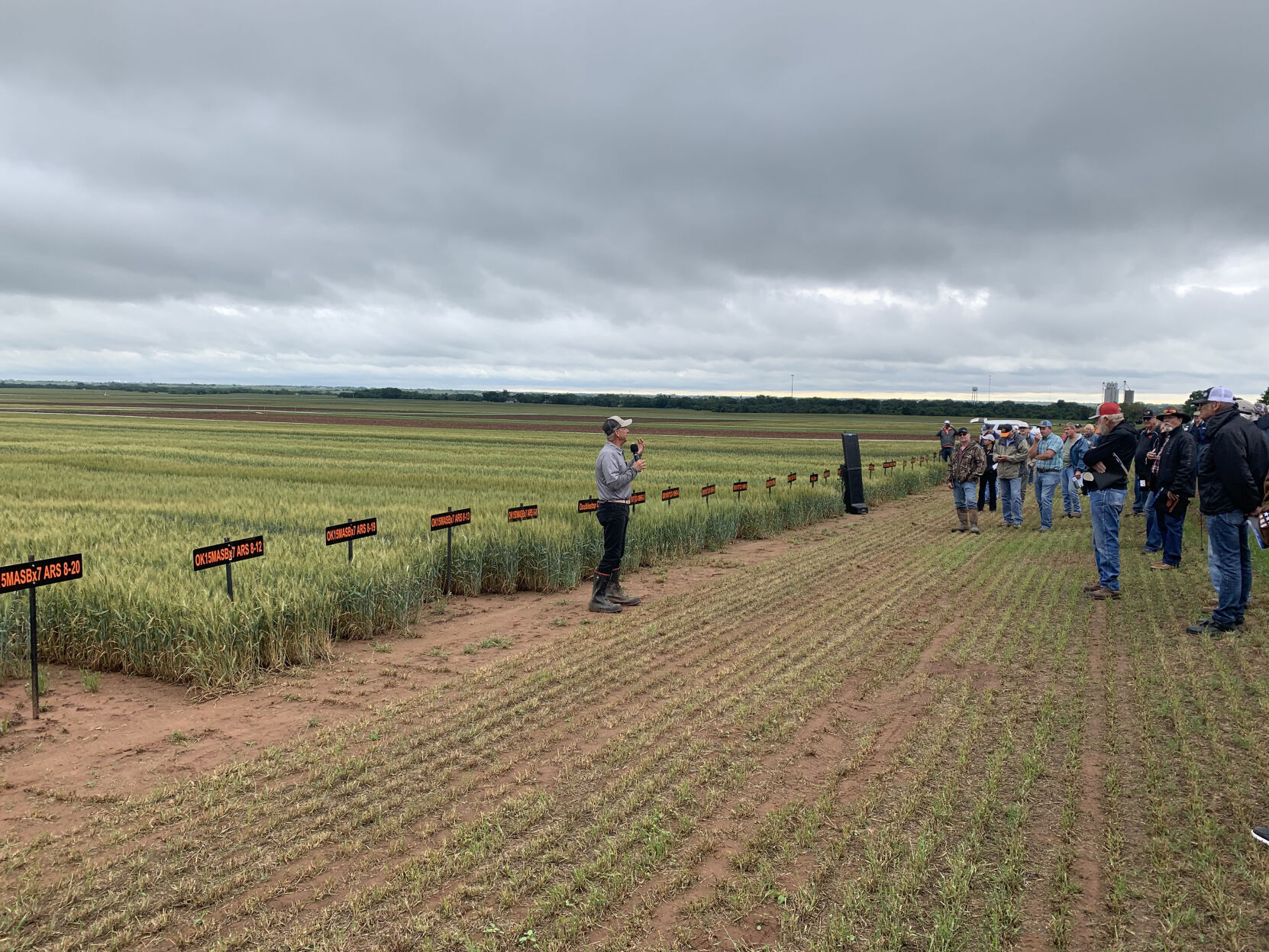Lahoma wheat tour speakers discuss diseases, weather and new varieties

The Lahoma Wheat Field Day was recently held at the North Central Research Station near Lahoma, Oklahoma. The tour was full, partly due to rainy conditions—a phenomenon that had eluded the High Plains for most of the wheat–growing season. In fact, several vehicles became stuck in the muddy parking area due to moist conditions and had to be pulled onto the gravel road with a tractor after the field day ended.
Several Oklahoma State University Extension specialists spoke at the field day, including Jason Warren, professor and Extension specialist in soil and water conservation management; Josh Lofton, associate professor and Extension economist and cropping systems specialist; Amanda Silva, assistant professor and Extension specialist for small grains; Josh Bushong, northwest district area Extension agronomist; Brian Arnall, professor and Extension specialist in precision nutrient management; Kim Anderson, professor emeritus and Extension specialist in grain marketing; Brett Carver, regents professor and wheat genetics chair and Meriem Aoun, assistant professor and small grains pathologist.
Aoun gave an update on the current state of the wheat crop and disease pressure plaguing fields across the High Plains. Some fields were released by crop insurance or baled into wheat hay due to extreme drought stress, but many fields held enough potential to harvest for grain and were able to capitalize on the widespread rain events that fell in late April and sporadically throughout May. Aoun said later planted fields benefited the most from the moisture because they are less mature. Certain diseases affect drought-stressed wheat more than wheat that has had adequate moisture.
“Many foliar diseases, like leaf spotting that we usually see around this time, were reduced this year,” Aoun said. “We have some other diseases that are favored by dry conditions. Have seen a lot of fusarium root rot. The symptoms are more obvious at the end of the season because you can see the white heads in the field.”
Aoun said the earlier planted wheat has been the most affected by root rot. Wheat with fusarium root rot will have pink color in the stem base. Plants can mature early and produce shriveled grain or the head may be empty of grain. Although root rot has been the most common disease this year, there are others that are popping up in fields.
“We also are seeing some leaf rust, which is caused by pathogens that are favored to dry conditions,” Aoun said. “Last year we had a lots of wheat streak mosaic virus, and this year we have received a few samples that tested positive.”
She said barley yellow dwarf virus has been found, especially around Stillwater, but it is common every year. Aoun said she had found some wheat with stripe rust before the heavy rains started, however it is not nearly as bad as previous years. Additionally, some powdery mildew and spot blotch have been reported. Some leaf rust has been spotted in Texas, although there has not been much in Oklahoma. No reports of leaf rust have been made in Kansas.
“Our crops are past the flowering stage, so it shouldn’t affect much,” Aoun said. “Mid-May there was heavy rain and in just one week there was enough to completely change the disease situation in the field. Now we’re seeing a lot of leaf spotting diseases.”
Aoun showed the crowd some leaves from the Lahoma site that showed signs of leaf spotting. But she said since it’s coming late in the season, she does not expect that to cause much damage. Although this wheat–growing season has been rocky, the late rain has caused some fields to bounce back with potential to make decent yields. The recent wet conditions are also a positive sign that we are finally on our way out of this terrible drought that has persisted.
New varieties coming soon
“It got a late start, but thank goodness because it came on pretty good,” Carver said. “Fallow is an important component in preserving yield and it saved our rears this year. We’ve got the yield to show for it, and we also didn’t have the root rot.”
Carver listed several new varieties he is particularly excited to release. One is a Gallagher derivative with high gluten strength characteristics. There are three closely related varieties in the group, but the front runner for Carver is a variety known as 8-29.
“We have official patent pending status on three lines, one of which is 8-29, which is 88% Gallagher,” he explained. “This has the functionality that is really off the charts for bakers with very strong gluten. Gallagher is strong, but not this strong and the new variety yields about five bushels more long term.”
He said some soil–borne mosaic virus and septoria has been reported in 8-29 this year, as it is not resistant to either disease.Carver particularly likes using it as breeding stock and said he would use it if it did not have the high functionality and gluten strength. He also spoke about High Cotton, a variety that was released this spring.
“Even under drought, this line performs better than just about anything else we have,” Carver explained.“On a five–year average, it’s at the top. This is also our first line coming from the Senate program in Turkey. It has a good combination of yield, disease and grazeability. We recommend this line on intensive management systems because it won’t get too tall and for grazing systems.”
Lacey Vilhauer can be reached at 620-227-1871 or lvilhauer@hpj.com.



